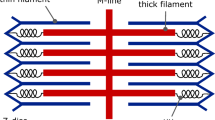Summary
We found that the isovolumic pressure-time curve of the canine left ventricle closely fitted the difference of two logistic function curves and that the isovolumic relaxation-pressure curve segment was more reliably characterized by a logistic time constant than by the conventional exponential time constant. We therefore hypothesized that the calcium (Ca) transient and the Ca-troponin (Tn) binding and crossbridge (CB) kinetics underlay the logistic character of the ventricular isovolumic pressure curve. We tested this hypothesis with a computer simulation of a simple Ca and CB kinetics model of myocardial isometric twitch force development. We assumed the isometric force curve (F) to be proportional to the instantaneous number of attached CBs that was theoretically given as the difference between the cumulative CB attachment and detachment curves. We radically changed the Ca transient, Ca-Tn binding, and CB kinetic parameters. We always found that both the cumulative CB attachment and detachment curves closely fitted logistic functions. The difference curve of these two best-fit logistic functions closely fitted the theoretical F curve with certain combinations of the Ca transient, the Ca-Tn binding, and the CB kinetic parameters. These results seem to support our hypothesis.
Similar content being viewed by others
References
Matsubara H, Araki J, Takaki M, Nakagawa ST, Suga H (1995) Logistic characterization of left ventricular isovolumic pressure-time curve. Jpn J Physiol 45:535–552.
Nwasokwa ON, Bodenheimer AM (1989) Analysis of myocardial isometric dynamics using parameters of a global model. Am J Physiol 257:H1210-H1521.
Sunagawa K, Yamada A, Senda Y, Kikuchi Y, Nakamura M, Shibata T, Nose Y (1980) Estimation of the hydromotive source pressure from ejecting beats of the left ventricle. IEEE Trans Biomed Eng 27:299–305.
Matsubara H, Takaki M, Yasuhara S, Araki J, Suga H (1995) Logistic time constant of isovolumic relaxation pressure-time curve in the canine left ventricle: Better alternative to exponential time constant. Circulation 92:2318–2326.
Rubinow SI (1975) Introduction to mathematical biology. John Wiley and Sons. New York, pp 11–17.
Yamaguchi H, Takaki M, Matsubara H, Yasuhara S, Suga H (1996) Constancy and variability of contractile efficiency as a function of calcium and crossbridge kinetics: Simulation. Am J Physiol 270:H1501-H1508.
Taylor TW, Goto Y, Suga H (1993) Variable cross-bridge cycling-ATP coupling accounts for cardiac mechanoenergetics. Am J Physiol 264:H994-H1004.
Namba T, Takaki M, Araki J, Ishioka K, Akashi T, Zhao LY, Matsushita T, Ito H, Fujii W, Matsubara H, Suga H (1993) Ca2+ sensitivity of contractile machinery and Ca2+ handling energy: Simulation. Jpn Heart J 34:601–616.
Suga H, Goto Y, Futaki S, Kawaguchi O, Yaku H, Hata K, Takasago T (1991) Cacium kinetics and energetics in myocardium: Simulation study. Jpn Heart J 32:57–67.
Robertson SP, Johnson JD, Potter JD (1981) The time course of Ca2+ exchange with calmodulin, troponin, parvalbumin, and myosin in response to transient increase in Ca2+. Biophys J 34:559–569.
Warber KD, Potter JD (1986) Contractile proteins and phosphorylation. In: Fozzard HA, Haber E, Jennings RB, Katz AM, Morgan HE (eds). The heart and cardiovascular system. Raven, New York, pp 779–788.
Burkhoff D (1994) Explaning load dependence of ventricular contractile properties with a model of excitation-contraction coupling. J Mol Cell Cardiol 26:959–978.
Suga H, Taylor TW (1991) Myocardial efficiency and economy in Huxley's 1957 crossbridge model. Jpn Heart J 32:827–834.
Huxley AF (1957) Muscle structure and theories of contraction. Prog Biophys Biophys Chem 7:257–318.
Woledge RC, Curtin NA, Homsher E (1985) Energetic aspects of muscle contraction. Academic, London, pp 277–308.
Brenner B (1988) Effect of Ca2+ on crossbridge turnover kinetics in skinned single rabbit psoas fibres: Implications for regulation of muscle contraction. Proc Natl Acad Sci USA 85:3265–3269.
Lee JA, Allen DG (1991) EMD 53998 sensitizes the contractile proteins to calcium in intact ferret ventricular muscle. Circ Res 69:927–936.
Peterson JN, Hunter WC, Berman MR (1991) Estimated time course of Ca2+ bound to troponin C during relaxation in isolated cardiac muscle. Am J Physiol 260:H1013-H1024.
Hodgkin AL, Huxley AF (1952) The dual effect of membrane potential on sodium conductance in the giant axon of Loligo. J Physiol (Lond) 116:497–506.
Ishikawa N, Kallman CH, Sagawa K (1984) Rabbit carotid sinus reflex under pentobarbital, urethane, and chloralose anesthesia. Am J Physiol 246:H696-H701.
Kent BB, Drane JW, Blumenstein B, Manning JW (1972) A mathematical model to assess changes in the baroreceptor reflex. Cardiology 57:295–310.
Sipido KR, Wier WG (1991) Flux of Ca2+ across the sarcoplasmic reticulum of guinea-pig cardiac cells during excitation-contraction coupling. J Physiol (Lond) 435: 605–630.
Weidmann S (1955) The effects of calcium ions and local anesthetics on electrical properties of Purkinje fibres. J Physiol (Lond) 129:568–582.
Fujino K, Sperlakis N, Solaro RJ (1988) Sensitization of dog and guinea pig heart myofilaments to Ca2+ activation and the inotropic effects of pimobendan: Comparison with milrinone. Circ Res 63:911–922.
Yasumura Y, Suga H (1988) Crossbridge model compatible with the linear relation between left ventricular oxygen consumption and pressure-volume area. Jpn Heart J 29:335–347.
Solaro RJ (1995) Troponin C-troponin I interactions and molecular signalling in cardiac myofilaments. Adv Exp Med Biol 382:109–115.
Dobrunz LE, Backx PH, Yue DT (1995) Steady-state [Ca2+]i-force relationship in intact twitching cardiac muscle: Direct evidence for modulation by isoproterenol and EMD 53998. Biophys J 69:189–201.
Landesberg A, Sideman S (1994) Mechanical regulation of cardiac muscle by coupling calcium kinetics with crossbridge cycling: A dynamic model. Am J Physiol 267:H779–795.
Author information
Authors and Affiliations
Rights and permissions
About this article
Cite this article
Sakamoto, T., Matsubara, H., Hata, Y. et al. Logistic character of myocardial twitch force curve: Simulation. Heart Vessels 11, 171–179 (1996). https://doi.org/10.1007/BF02559989
Received:
Revised:
Accepted:
Issue Date:
DOI: https://doi.org/10.1007/BF02559989



